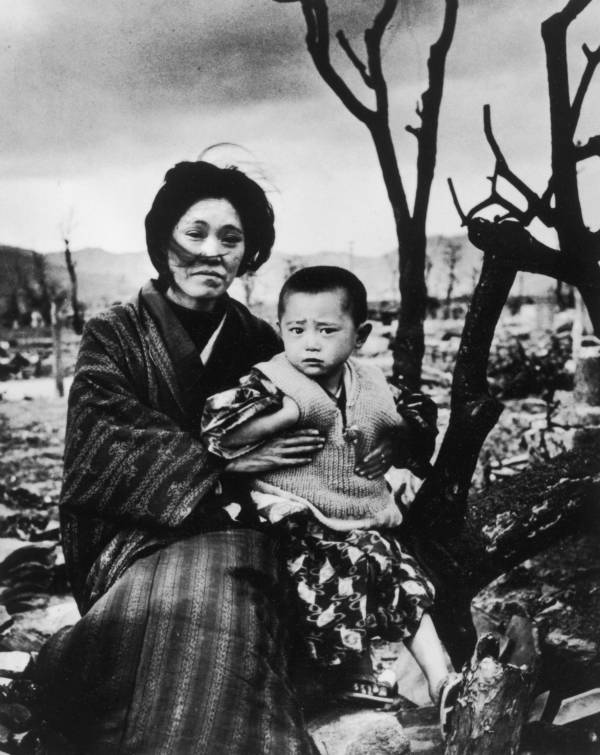Long Term Social Impact
After 10-50 years the effects of the bomb still had consequences on people. people who lived around the bombing experienced radiation symptoms, fatigue, high fevers, epilation, nausea, vomiting, bleeding from the gums, cataracts, diarrhea, leukopenia, and purpura. Between the years 1950 and 1990, there were nearly 430 reported deaths from cancer that were attributed to radiation, with the highest proportion of individuals dying from cancer higher among those who were closest to the hypocenter.
(Sawada)

A mother and child sit in the ruins of Hiroshima four months
after the bombing.
(Eisenstaedt)

Shortly after signing the San Francisco peace treaty on September 8, 1951,
Japan’s Prime Minister Shigeru Yoshida signs the Security Treaty Between
the United States and Japan.
(Getty Images)
Japan After The War
The United States led Allied Forces to help Japan bring drastic changes, Japan was disarmed and its empire was dissolved. The government changed into democracy rebuilding its economy and education system. After the war and all its destruction from thousands of raids, atomic weapons, it took years of reconstruction to recover, The enemy of World war 2 for japan became an ally, America became allies with japan and became apart of the Japanese landscape.
(Taylor)
Ban On Nuclear Weapon
After decades of campaigning for a world without nuclear weapons, a treaty was created to prohibit nuclear weapons in 2017, Hibakusha are survivors from the bombigns of Hiroshima and Nagasaki and are trying to eliminate nuclear weapons. In a survey with 6000 Hibakusha showed that a vast majority feel that Japan should join the U.N treaty banning nuclear weapons, joining the treaty would represent a recognition by Japan on its affected citizens rights and suffering.
(Ican)

Coretta Scott King (R) with Women Strike for Peace founder Dagmar Wilson (L) in a march on the United Nations Plaza, New York City
(Bettmann)

Test of the tactical nuclear weapon “Small Boy” at the Nevada Test Site, July 14, 1962.
(National Nuclear Security Administration)
Cold War
Post World War 2 there was a tension between Soviet Unions and the United States leading into a worldwide Cold War. Soviet Union leader Joseph Stalin was offended and raised suspicion on the United States after US president Harry Truman did not infor Stalin of his intent to deploy nuclear weapons on Japan. This led into the arms race, in 1949 USSR tested its first atomic bombing leading to a race between the two superpowers to amass the most powerful nuclear wepon with the most effective delivery system. Nuclear weapons became a deterrent rather than a weapon to use in warfare.
(BBC)